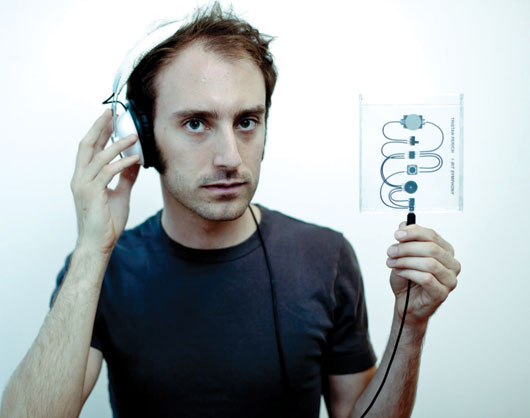Bit and Pieces: Tristan Perich’s 1-Bit Opus Takes the Idea of ‘Lo-Fi’ in a Whole New Direction
Tristan Perich‘s 2005 release, 1-Bit Music, presented an idea so straightforward, it was a little […]

Bit and Pieces: Tristan Perich’s 1-Bit Opus Takes the Idea of ‘Lo-Fi’ in a Whole New Direction
Tristan Perich‘s 2005 release, 1-Bit Music, presented an idea so straightforward, it was a little […]

Tristan Perich‘s 2005 release, 1-Bit Music, presented an idea so straightforward, it was a little revolutionary: By inserting a single microchip, along with a headphone jack and some simple controls, into a CD jewel case, he replaced recorded music with a device that literally recreated the music each time it was turned on. Five years later, he presents a sequel of sorts: 1-Bit Symphony, an electronic composition in five movements that manages to cram more musical ideas (and more executable lines of code) into the same 8 kilobytes of storage. We asked the New York-based composer and video artist to describe his process and his continued fascination with digital audio’s smallest unit of exchange.
Genesis
1-Bit Music was a beginning that needed a conclusion. For 1-Bit Symphony, I returned to my role as a composer, writing music for traditional classical ensembles but strangely accompanied by 1-bit audio. Somehow combining beautiful old instruments with harsh electronics seemed entirely logical. I spent a lot of time thinking about the identity of these traditional instruments versus the identity of electronics. They clearly come from different places, but it’s surprising how much primitive electronics shares with those old things.
Speaking in Code
My first 1-bit album was composed entirely in code. This came out of the fact that its pitch system was based on mathematical ratios and didn’t map to ‘regular’ instruments very well. For 1-Bit Symphony, I wrote all the code from scratch, employing our traditional Western pitch system of half-steps, so finally my musical ideas could translate more directly to encoded composition. I sketched ideas for the music in desktop audio software, which connected to a special version of the electronics that I created to take input from a computer. That way I could work on the level of music instead of data.
New Directions
Music has always involved programming languages. Traditional sheet music instructs performers on what to do. On 1-Bit Symphony, I’m instructing the microchip to create sound by doing some calculations here and there and outputting their results. It’s this low-level approach to process that interests me.
Mystery Man
Somehow everyone finds the process of downloading code onto a chip extremely mysterious. Maybe it’s reminiscent of movies, where someone has their brain rewritten with new software, like Dark City or something. In my case it’s a little like synching an iPod, but closer to flash-upgrading the software for your 56k modem in the ’90s. The chips plug into a programming interface (in my case, the tuxgraphics AVR-USB), which connects to my computer, which downloads the software with some open-source tools.
How We Do
I run a sweatshop out of my New York studio, where I have four assistants who dutifully assemble each copy. A lot of work goes into the process, including drilling the case, preparing and gluing the components, soldering the circuit, testing, and packaging. If anyone somehow gets a copy that doesn’t work, please write me and let me know, and I’ll fire somebody.
1-Bit Symphony is out now on Cantaloupe.

